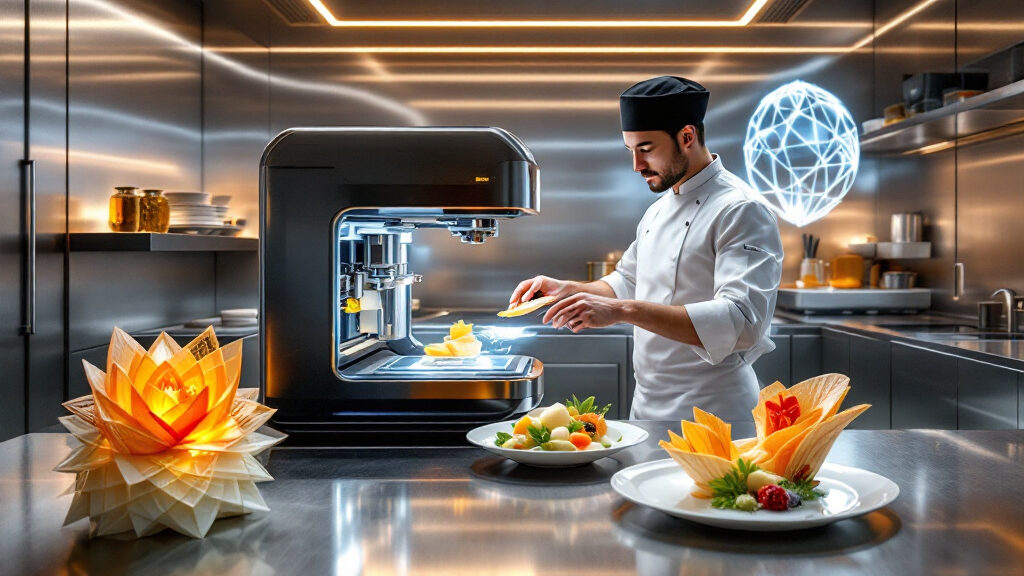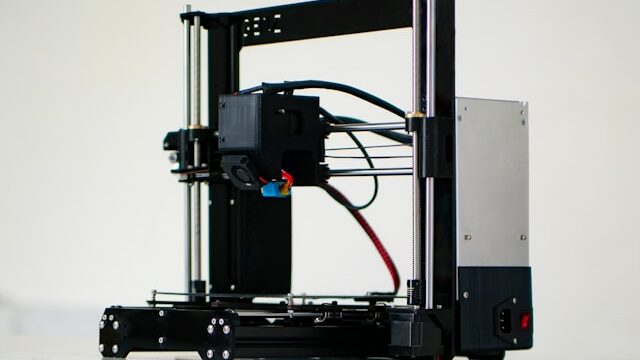Do you want to learn more about the specifics and functioning of 3D printing in cooking? At Imprimy.com, we are here to answer all your questions.

What is 3D culinary printing?
3D culinary printing is a specific form of 3D printing that enables the production of edible foods using the specialized processes associated with 3D printing technology.
The definition of 3D culinary printing
3D culinary printing is an innovative technique that uses 3D printing technology to create food by layering edible materials such as pastes, chocolate, or purées based on a digital model.
This method enables the production of complex shapes and unique designs, adding a new dimension to presentation and dish customization. It paves the way for more creative and precise cooking, while optimizing ingredient use and reducing waste.
A brief history of 3D culinary printing
The history of 3D culinary printing began in the early 2000s, with the first experiments aimed at adapting 3D printing technology, originally developed for industrial materials, to edible substances.
In 2007, the Fab@Home project marked a turning point by allowing users to create three-dimensional objects from various materials, including food. In 2013, NASA funded a project to develop a 3D printer capable of producing pizzas in space, highlighting the potential of this technology for extreme environments.
Since then, companies have developed specialized 3D printers for cooking, enabling chefs and enthusiasts to push the boundaries of culinary creativity.
How 3D culinary printing works
The operation of 3D culinary printing is based on the principle of additive manufacturing, where successive layers of edible materials are deposited to create a three-dimensional shape. The process begins with the design of a digital model using 3D modeling software. This model is then sent to the 3D culinary printer, which uses cartridges or syringes containing ingredients such as pastes, purées, chocolate, or food gels.
The printer deposits these ingredients layer by layer, following the instructions of the model, until the desired shape is achieved. This technique allows the creation of complex and customized food structures, offering unmatched precision and creativity in the presentation of dishes.
Can 3D printing lead to a culinary revolution?
3D printing in cooking can enable new applications, characterized by major innovations in this field.
The different culinary applications of 3D printing
The culinary applications of 3D printing are varied and innovative, offering new possibilities in the field of gastronomy. Among the main applications are the creation of complex desserts, such as sugar or chocolate structures, which would be difficult to achieve manually.
3D printing also allows for the customization of dishes, adapting shapes and textures to individual preferences. In the pastry sector, it is used to create elaborate decorations and precise geometric shapes.
Furthermore, 3D printing finds applications in personalized nutrition, enabling precise control over the quantity and distribution of nutrients in food. It is also being explored for large-scale food production, especially in environments where traditional supplies are limited, such as in space. These applications demonstrate the potential of 3D printing to transform cooking into an even more creative and efficient experience.
The main advantages of 3D printing in cooking
The main advantages of 3D printing in cooking lie in its ability to offer unmatched precision in creating complex and detailed shapes, enabling an extremely careful presentation of dishes. It also fosters culinary creativity, allowing chefs to explore new textures and structures that would be impossible to achieve with traditional techniques. 3D printing allows for greater customization of meals, catering to the specific needs of clients, whether it’s for taste preferences or nutritional requirements.
Furthermore, it contributes to reducing food waste by using only the necessary amount of ingredients, which is beneficial both economically and ecologically. Finally, this technology offers a significant time-saving by automating certain repetitive tasks, allowing professionals to focus on other aspects of culinary preparation.
The numerous innovations applied to 3D culinary printing
The innovations applied to 3D culinary printing are numerous and continuously transform the gastronomic landscape. Among these, we find the development of new edible materials, such as food inks and gels, which allow for the creation of unique textures and flavors. Multimaterial 3D printers capable of combining several ingredients in a single print pave the way for even more complex and flavorful dishes. Integrated cooking technology enables the cooking of food directly during the printing process, thus optimizing preparation time.
Furthermore, advanced modeling software makes it easier to design custom recipes, while artificial intelligence is used to optimize recipes and printing processes. Finally, research is underway to integrate specific nutrients into the prints, thus meeting individual nutritional needs and paving the way for customized diets. These innovations demonstrate the potential of 3D printing to revolutionize modern cooking.
What are the advantages of 3D printing in cooking?
The advantages of 3D printing in cooking are related to time savings provided by this technology, applied nutrition, and the reduction of waste.
Time savings associated with 3D printing in cooking
The time savings associated with 3D printing in cooking are significant and manifest in several ways. First, 3D printing allows for the automation of repetitive and time-consuming tasks, such as creating complex decorations or reproducing identical shapes, freeing up time for chefs to focus on other creative aspects of culinary preparation.
Additionally, the precision of 3D printing reduces errors and manual adjustments, speeding up the production process. The ability to program prints in advance also enables efficient meal preparation scheduling, optimizing the workflow in the kitchen.
Finally, some 3D culinary printers incorporate cooking functions, allowing food to be cooked directly during the printing process, which further reduces the overall preparation time. These time savings contribute to a more efficient resource management and an improvement in productivity in the kitchen.
Waste reduction through 3D culinary printing
Waste reduction through 3D culinary printing is a major advantage of this technology. By using only the exact amount of ingredients needed to create a dish, 3D printing minimizes food waste often associated with traditional preparation methods. This precision allows for optimized use of raw materials, thereby reducing waste.
Additionally, the ability to customize portions enables better adaptation of quantities to the actual needs of consumers, avoiding excess. Finally, 3D printing can contribute to the reuse of food scraps by integrating them into new culinary creations, thus extending the lifespan of ingredients and reducing the environmental impact of food waste.
Personalized nutrition applied to 3D printing in cooking
Personalized nutrition applied to 3D printing in cooking represents a major advancement in the field of customized food. With this technology, it is possible to precisely control the nutritional composition of printed food, adjusting the quantities of nutrients such as vitamins, minerals, proteins, and fibers, according to individual needs. This allows for meeting specific requirements, whether related to special diets, food allergies, or medical conditions requiring tailored nutrition.
3D printing also allows for the creation of varied textures, making it easier for people with difficulty chewing or swallowing to consume food. By integrating personal data, such as age, gender, physical activity level, and food preferences, chefs and nutritionists can design fully customized meals, optimizing the health and well-being of individuals. This approach paves the way for more precise and tailored nutrition, revolutionizing the nutrition sector.
What are the limitations of 3D printing in cooking?
3D printing in cooking also has certain limitations, such as high costs, the need for sometimes intensive training, and regulations that can prove problematic.
The cost of the technology enabling 3D culinary printing
The cost of the technology enabling 3D culinary printing can vary significantly depending on several factors. The initial investment for a professional-grade 3D culinary printer can be high, often ranging from several thousand to tens of thousands of euros. This cost includes not only the purchase of the printer itself but also the modeling and design software required to create the 3D models.
Additionally, the edible materials used for printing, such as specialized ingredient cartridges, can represent a significant recurring cost. Maintenance and technology updates must also be considered to ensure the continued functionality and efficiency of the equipment.
However, despite these initial costs, the potential benefits in terms of waste reduction, meal customization, and operational efficiency can offer an attractive return on investment for restaurant professionals.
Training for using 3D culinary printers
Training for using 3D culinary printers is essential to fully leverage this innovative technology. Training programs generally cover several key aspects:
- Understanding how it works: Training introduces participants to the basic principles of 3D printing, explaining how printers operate and their specific applications in the culinary field.
- 3D modeling: Users learn to design 3D models using specialized software. This step is crucial for creating the desired shapes and structures before printing.
- Using slicing software: Training teaches how to prepare 3D files for printing using slicing software, which converts models into instructions understandable by the printer.
- Handling the printer: Participants learn how to set up, calibrate, and maintain 3D printers. This includes loading materials, launching prints, and troubleshooting common issues.
- Hands-on and certification courses: Some programs offer hands-on sessions in small groups, providing a personalized and intensive learning experience. Certifications may also be awarded upon completion of the training.
- Financing and accessibility: Training may be funded through programs like the Personal Training Account (CPF) or grants for job seekers, making it easier to access these skills.
These training programs allow chefs and enthusiasts to master 3D culinary printing, opening up new creative and technical possibilities in the world of gastronomy.
Regulations related to food safety and compliance in 3D printing
Regulations related to food safety and compliance in 3D printing are crucial to ensure that objects printed for contact with food are safe and meet hygiene standards. Here are some key points to consider:
- Approved Materials: The materials used for 3D printing must be certified as safe for food contact. This includes filaments and resins that comply with established standards.
- Safety Practices: 3D printed objects must be designed and manufactured to prevent bacterial contamination risks. Small cracks and gaps in the prints can harbor bacteria, so strict cleaning protocols must be followed.
- Certifications and Standards: 3D prints intended for food contact often need to meet specific standards set by various regulatory bodies. These certifications ensure that the materials used pose no health risks.
- Technical Considerations: The 3D printing process itself, such as FDM (Fused Deposition Modeling) or SLA (Stereolithography) technologies, must be adapted to minimize contamination risks. This might involve using coatings or post-printing treatments to seal surfaces.
- Training and Awareness: Users must be trained in best practices for food safety and handling 3D printers to ensure that printed objects are safe for food use.
These regulations and practices are designed to ensure that 3D printing can be safely used in the food industry, promoting innovation while adhering to food safety standards.
What is the future of 3D printing in cooking?
The future of 3D culinary printing looks bright, as its impact and future trends seem to point toward particularly exciting advancements.
Future trends in 3D culinary printing
The future trends in 3D culinary printing promise to innovate and transform the food industry. Here are some key trends:
- Food Personalization: 3D printing will enable the creation of customized meals tailored to individual preferences in terms of taste, texture, and nutritional needs. Consumers will be able to personalize their dishes directly from their kitchen, thanks to home 3D food printers.
- Sustainability and Waste Reduction: 3D culinary printing will help reduce food waste by using only the exact amount of ingredients needed and optimizing production processes. This technology could also promote the use of sustainable and local ingredients.
- Restaurant Innovation: Restaurants are starting to integrate 3D printing to offer unique culinary experiences. 3D printed dishes could become attractions on menus, drawing customers in with innovative presentations and complex flavors.
- Nutrition and Health: 3D printing will allow for precise control over the nutritional composition of food, addressing specific needs such as dietary restrictions or medical requirements. This precision paves the way for healthier, more tailored diets.
- Expansion of Materials and Techniques: The development of new edible materials and advanced printing techniques will broaden culinary possibilities. Research is underway to create printable materials that mimic the texture and taste of traditional foods.
- Technological Integration: 3D culinary printing will increasingly integrate with other technologies, such as the Internet of Things (IoT) and Artificial Intelligence (AI), to automate and optimize meal preparation. Smart kitchens will become centers of food innovation.
These trends show that 3D culinary printing is set to become a key technology in the evolution of the food industry, offering innovative solutions to current and future challenges.
The impact of 3D food printing on the food industry
The impact of 3D food printing on the food industry is significant and multidimensional, transforming various aspects of food production, from distribution to consumption. Here are some key impacts:
- Innovation and Creativity: 3D printing allows chefs and food businesses to explore new forms, textures, and culinary presentations. This technology stimulates creativity and enables the creation of complex designs that would be difficult or even impossible to achieve with traditional methods.
- Mass Customization: 3D printing allows for the large-scale customization of food, addressing individual consumer preferences. This includes adapting meals to specific nutritional needs, dietary restrictions, or medical conditions.
- Efficiency and Waste Reduction: By using only the necessary amount of ingredients and optimizing production processes, 3D printing helps reduce food waste. This efficiency is beneficial both economically and environmentally.
- Automation and Time Savings: 3D printing can automate certain repetitive tasks in food preparation, allowing professionals to focus on other creative or strategic aspects of their work. This can lead to time savings and improvements in productivity.
- New Business Models: 3D printing opens the door to new business models in the food industry, such as on-demand printing services or customized food kits. These innovations could transform the way food is produced and distributed.
- Challenges and Adaptations: While promising, 3D food printing also presents challenges, particularly in terms of regulations, high initial costs, and staff training. The industry must adapt to these challenges to fully integrate this technology into food processes.
In summary, 3D food printing has the potential to revolutionize the food industry by introducing innovations that enhance efficiency, customization, and sustainability, while also presenting new challenges that require adaptation.
Conclusion: 3D printing in cooking
Conclusion: 3D printing in cooking is a transformative technology that offers exciting possibilities for the food industry. By enabling creativity, customization, and efficiency, it has the potential to revolutionize how food is prepared, distributed, and consumed.
While challenges such as costs, regulation, and staff training exist, the benefits of reduced food waste, personalized meals, and new business models make it a promising tool for the future. As the technology evolves, it is likely to play a crucial role in shaping the future of culinary arts and the food industry as a whole.
Image generated by Le Chat, an artificial intelligence model developed by Mistral AI.
The articles published on Imprimy.com are for informational purposes only. They are intended to provide general advice and information related to 3D printing. Imprimy.com cannot be held responsible for the results obtained or the consequences arising from the application of the shared information. We recommend always checking the specific instructions for your hardware and materials before use.


